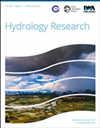Projection of disaster-causing risk of extreme precipitation in the Yangtze River Basin based on CMIP6
IF 2.4
4区 环境科学与生态学
Q2 Environmental Science
引用次数: 0
Abstract
Extreme precipitation is very sensitive to climate change. Global warming will significantly affect the frequency and intensity of extreme precipitation and further affect the spatio-temporal pattern of disaster-causing risk of extreme precipitation. This study analyzes the spatio-temporal trends of extreme precipitation and projects its disaster-causing risk under different climate scenarios in the Yangtze River Basin from 2021 to 2100. The results indicate that the extreme precipitation in the Yangtze River Basin shows an increasing trend in the future. Annual precipitation (PRCPTOT) increases by 33.05–42.56% under five scenarios compared with the historical period. The future change in heavy precipitation (R95p) also shows a significant increase, but heavy rain days (R50) and 5-day maximum precipitation (RX5day) decrease. The disaster-causing risk of extreme precipitation in the Yangtze River Basin is mainly Levels III and IV, accounting for 57.23–65.99% of the total basin area. The area with Level V is mainly distributed in the Poyang Lake Basin and the lower main stream of the Yangtze River. Moreover, the changes in disaster-causing risk of extreme precipitation are mainly manifested in the decrease of areas with low risk (Levels I and II) and the increase of areas with medium risk (Levels III and IV) in different periods.基于CMIP6的长江流域极端降水灾害风险预测
极端降水对气候变化非常敏感。全球变暖将显著影响极端降水的频率和强度,并进一步影响极端降水灾害风险的时空格局。本研究分析了2021年至2100年长江流域不同气候情景下极端降水的时空趋势,并预测了其灾害风险。结果表明,未来长江流域极端降水量有增加的趋势。与历史时期相比,在五种情况下,年降水量(PRCPTOT)增加了33.05–42.56%。未来强降水量(R95p)的变化也显著增加,但暴雨天数(R50)和5天最大降水量(RX5天)减少。长江流域极端降水灾害风险主要为Ⅲ、Ⅳ级,占流域总面积的57.23~65.99%。五级区域主要分布在鄱阳湖流域和长江下游干流。此外,极端降水灾害风险的变化主要表现为不同时期低风险地区(Ⅰ级和Ⅱ级)的减少和中风险地区(Ⅲ级和Ⅳ级)的增加。
本文章由计算机程序翻译,如有差异,请以英文原文为准。
求助全文
约1分钟内获得全文
求助全文
来源期刊

Hydrology Research
Environmental Science-Water Science and Technology
CiteScore
5.30
自引率
7.40%
发文量
70
审稿时长
17 weeks
期刊介绍:
Hydrology Research provides international coverage on all aspects of hydrology in its widest sense, and welcomes the submission of papers from across the subject. While emphasis is placed on studies of the hydrological cycle, the Journal also covers the physics and chemistry of water. Hydrology Research is intended to be a link between basic hydrological research and the practical application of scientific results within the broad field of water management.
 求助内容:
求助内容: 应助结果提醒方式:
应助结果提醒方式:


